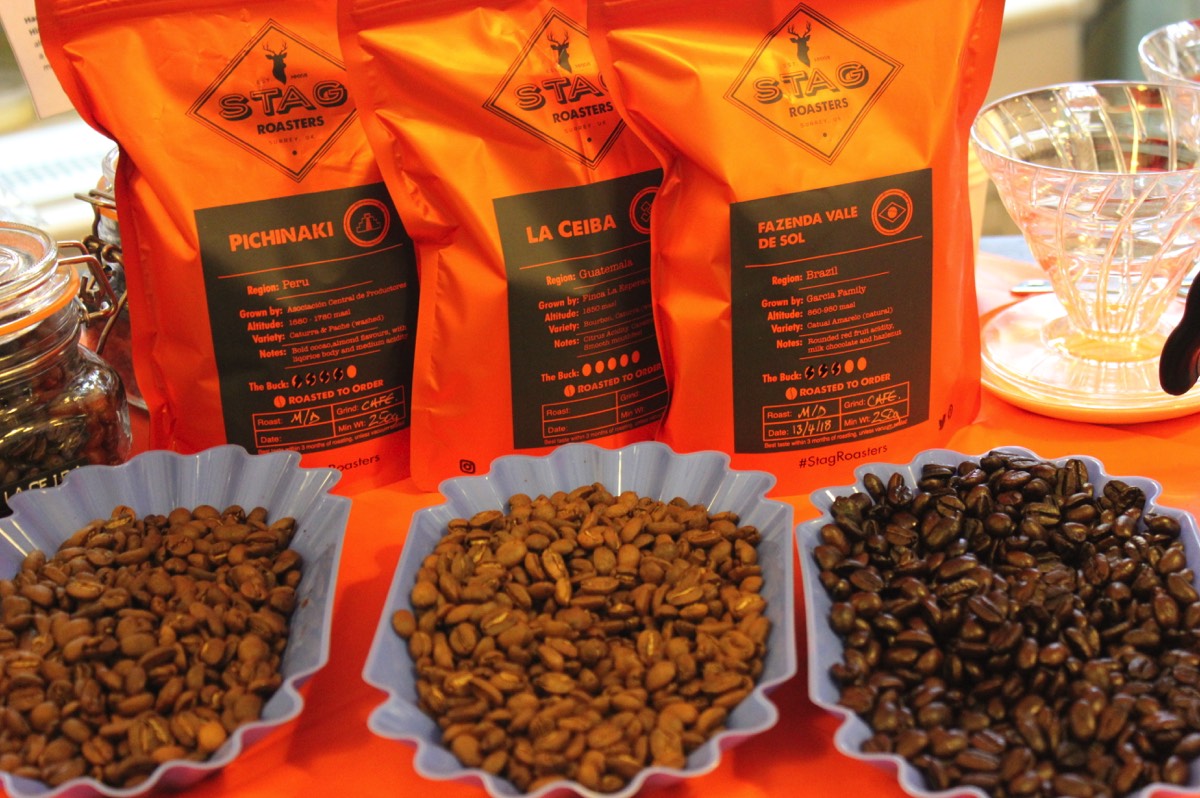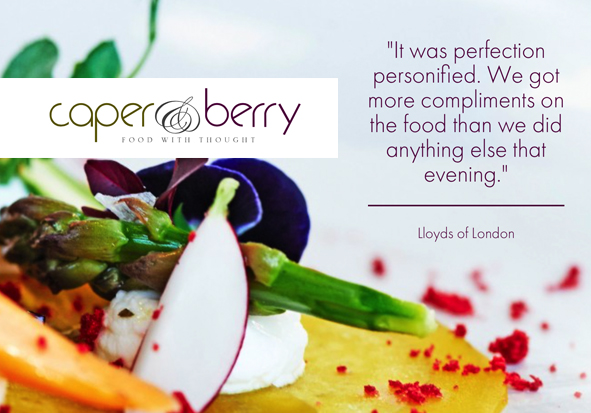ARTISAN FOOD
Surrey’s Premier Lifestyle Magazine
Stag Roasters...a real ‘crack’ above the rest
During my time writing about the local food movement, I have seen the arrival of several new coffee roasters. Independent coffee roasters and coffee shops are making a welcome return to the high street by offering beans roasted to give their best flavour profile and a great drinking experience. It’s a win-win when customers are supporting a small grower who is also being paid a fair price.
Stag Roasters is based at Simon Evans’ home in Farncombe, near Godalming, in Surrey. He bought the property recently and meticulously renovated it to house both him and his business. Simon’s roasting room is based in his garage: small, perfectly formed and spotlessly clean (he was awarded a five star hygiene rating from his local council).
This was not Simon’s first career choice, but one that he purposed for himself after running out of steam in a job that took him all over the world. He soon began to realise there may be a gap for well sourced and roasted coffee, so he set out to offer expertly roasted beans from single estates. Whilst origin is important, Simon did not want to stick to already well-known growing areas and producers, so has worked hard to bring a range of coffees to the market to give exposure to lesser known producers such as those in Peru and Honduras. He also advises on coffee making equipment. At Secretts at Hurst Farm in Milford, in addition to roasted coffee and whole beans, a range of coffee making solutions can be purchased, curated by Simon for the business.

So, whilst making his new house into his home, Simon also started researching the world of coffee which, it turns out, is a little bit more complicated than we might think. First off, it’s all about growing countries, then it’s the variety of bean, the altitude it’s grown at, how much sun the growing area has each day, what the temperature is and how long it takes to ripen. Lower quality coffee beans used for instant tend to be grown at lower altitude, in sun soaked plots. More refined coffee is grown higher up (like tea) and in plots that have more shade (referred to as shade grown); revered for slower ripening and growing times, this is reported to improve the final flavour of the roasted bean. With a degree in aerospace manufacturing and engineering and a Masters in operational excellence, this coffee roaster was able to deftly deal with all his new found knowledge and process it to ensure he set himself on the right path.
This is the third time I have written about a Surrey roaster, so I wasn’t sure what to expect. I should have known better. Simon approaches his product development in a refreshing way and to him it’s all about the ‘crack’. This is a key to excellence for any coffee roaster and I was, by this time, all ears. It doesn’t matter where the coffee comes from, if you don’t listen to it properly when roasting it, you can destroy a really good bean if the roasting profile is wrong. So, having chosen a bean on which to start practicing, Simon taught himself how to roast coffee, sampling each batch, until he developed an understanding of the process from start to finish.
This is the third time I have written about a Surrey roaster, so I wasn’t sure what to expect. I should have known better. Simon approaches his product development in a refreshing way and to him it’s all about the ‘crack’. This is a key to excellence for any coffee roaster and I was, by this time, all ears. It doesn’t matter where the coffee comes from, if you don’t listen to it properly when roasting it, you can destroy a really good bean if the roasting profile is wrong. So, having chosen a bean on which to start practicing, Simon taught himself how to roast coffee, sampling each batch, until he developed an understanding of the process from start to finish.

Simon Evans
The deal is to start the roast and wait for the first crack (a similar noise to popcorn when it starts to pop), but coffee isn’t a starch-packed bean, so it makes a popping sound, but without the expansion. By the first crack, a mild roast coffee will have been created which is just starting to turn a golden brown. By the time the second crack is reached, the right roasting time for a medium roast coffee has been reached. On first crack, careful heating of the beans correctly to a higher temperature is essential, keeping a steady roast at an even temperature. Simon takes his coffee to a medium roast to just before the second crack. This means the coffee develops a full flavour and retains its caffeine without developing a bitter, burnt flavour profile. For a darker coffee, the roast is taken to a higher temperature and to beyond the second crack.
Coffee is cooled quickly after roasting to ensure flavour is retained and once cold is stored in Stag’s moisture-proof bags: moisture and oxygen are both culprits in deteriorating coffee.
Stag currently carries seven different coffees from growing regions such as Brazil, Honduras, Ethiopia, Guatemala and Peru. My favourite from our sampling session was the Pinchinaki from Peru which has a lovely medium roast profile. Stag has two versions of this in both regular and decaffeinated. At a recent tasting at Secretts, all of Simon’s coffees sold really quickly.
Simon explains: “I decide where to source my beans after extensive research of a region, from the climate to the altitude, and the processing techniques of the raw coffee beans. I prefer to select beans that provide a truly rich and smooth-bodied flavour and further enhance these through my roasting technique.”
A one-man band, Simon has created his packaging, brand, website and marketing materials virtually single-handed. This is a local Surrey business well worth supporting: Simon’s coffee can be bought from a limited range of retailers, including Secretts, or direct from his on-line shop. Full details on his website.
Coffee is cooled quickly after roasting to ensure flavour is retained and once cold is stored in Stag’s moisture-proof bags: moisture and oxygen are both culprits in deteriorating coffee.
Stag currently carries seven different coffees from growing regions such as Brazil, Honduras, Ethiopia, Guatemala and Peru. My favourite from our sampling session was the Pinchinaki from Peru which has a lovely medium roast profile. Stag has two versions of this in both regular and decaffeinated. At a recent tasting at Secretts, all of Simon’s coffees sold really quickly.
Simon explains: “I decide where to source my beans after extensive research of a region, from the climate to the altitude, and the processing techniques of the raw coffee beans. I prefer to select beans that provide a truly rich and smooth-bodied flavour and further enhance these through my roasting technique.”
A one-man band, Simon has created his packaging, brand, website and marketing materials virtually single-handed. This is a local Surrey business well worth supporting: Simon’s coffee can be bought from a limited range of retailers, including Secretts, or direct from his on-line shop. Full details on his website.
Photo copyright: Dan Edwards

Coffee-rich, light tiramisu
Layers of fresh coffee chocolate sponge steeped in coffee and liqueur with light mascarpone.
Serves 4
For the sponge
Three large eggs
75g caster sugar
50g plain gluten-free flour
40g fresh roasted coffee beans, finely ground
25g cocoa powder
Filling
500ml light mascarpone
250ml light crème fraîche
80g icing sugar
180ml strong freshly brewed coffee, cooled
60ml of Marsala or Amaretto (or any liqueur of choice)
Chocolate cake, cut into eight rounds
Cocoa powder, for dusting
Method
- Preheat oven to 200°C/fan 180°C or gas mark 5.
- Sit a large heatproof bowl over a pan of just simmering water, add the eggs and sugar and whisk for five to ten minutes when the mixture should be thick and creamy. Mix the flour, coffee and cocoa powder together and fold in gently with a metal spoon. Line a Swiss roll tin with non-stick baking paper. Pour the mixture into the tin and bake for ten minutes or until springy to touch. Remove from oven and allow to cool. Meanwhile, make the filling.
- Place the mascarpone, crème fraîche, sugar and 60ml of the coffee in a medium bowl and mix until combined. Set aside.
- Place the remaining coffee and liqueur in a shallow dish. Dip four of the sponge rounds into the remaining coffee mixture and place in the bases of four x 375ml glasses; if this seems a little fiddly, place the cake in the glasses and then drizzle a little coffee over each one. Divide half the cream mixture between the glasses. Dip remaining cake rounds into the coffee and place on top of the cream mixture. Spoon over the remaining cream mixture and decorate with cocoa and chill until required.
Shirlee Posner, eatsurrey.co.uk
Layers of fresh coffee chocolate sponge steeped in coffee and liqueur with light mascarpone.
Serves 4
For the sponge
Three large eggs
75g caster sugar
50g plain gluten-free flour
40g fresh roasted coffee beans, finely ground
25g cocoa powder
Filling
500ml light mascarpone
250ml light crème fraîche
80g icing sugar
180ml strong freshly brewed coffee, cooled
60ml of Marsala or Amaretto (or any liqueur of choice)
Chocolate cake, cut into eight rounds
Cocoa powder, for dusting
Method
- Preheat oven to 200°C/fan 180°C or gas mark 5.
- Sit a large heatproof bowl over a pan of just simmering water, add the eggs and sugar and whisk for five to ten minutes when the mixture should be thick and creamy. Mix the flour, coffee and cocoa powder together and fold in gently with a metal spoon. Line a Swiss roll tin with non-stick baking paper. Pour the mixture into the tin and bake for ten minutes or until springy to touch. Remove from oven and allow to cool. Meanwhile, make the filling.
- Place the mascarpone, crème fraîche, sugar and 60ml of the coffee in a medium bowl and mix until combined. Set aside.
- Place the remaining coffee and liqueur in a shallow dish. Dip four of the sponge rounds into the remaining coffee mixture and place in the bases of four x 375ml glasses; if this seems a little fiddly, place the cake in the glasses and then drizzle a little coffee over each one. Divide half the cream mixture between the glasses. Dip remaining cake rounds into the coffee and place on top of the cream mixture. Spoon over the remaining cream mixture and decorate with cocoa and chill until required.
Shirlee Posner, eatsurrey.co.uk
essence info
Website: www.stagroasters.co.uk
Shirlee Posner is a food writer and blogger at www.eatsurrey.co.uk and provides social media management, web copywriting and food photography.
The deal is to start the roast and wait for the first crack (a similar noise to popcorn when it starts to pop), but coffee isn’t a starch-packed bean, so it makes a popping sound, but without the expansion. By the first crack, a mild roast coffee will have been created which is just starting to turn a golden brown.



